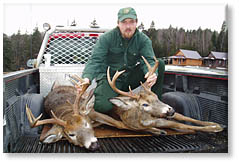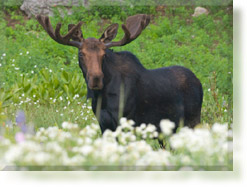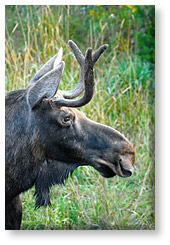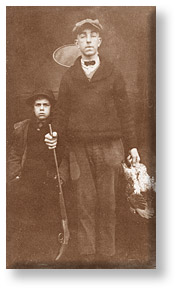Hunting
Bear Hunting
Black Bear inhabit our Great North Woods. It is estimated that our bear population is equivalent to 0.6 bear per square mile.
The hunting season opens in September and lasts a little over two months. Black bears inhabit forested areas with thick understory vegetation. Wetlands and riparian areas are also important components of their habitat. Optimal habitat typically includes large tracks of forest with little human disturbance. The fall mast crop could create some exciting opportunities for bear hunters. Fall mast crops include raspberry, blackberry, chokecherry, mountain ash, acorn and apple. Bears feed heavily in areas where these species are typically found including field edges, old clear cuts and along old woods roads. The key to success will be to scout out areas with the above-mentioned food sources and look for evidence of recent bear-feeding activity. If active bear sign is found in an area where available food remains, patience and persistence often equal success.
Visit the NH Fish and Game for specific dates and hunting rules for Black Bear.
Something’s Bruin – Living with Bears in NH
Buy your NH Hunting License Online today!

Northernmost New Hampshire’s rugged mountainous terrain provides the ideal habitat for northern white-tail deer. Pittsburg’s 200,000 acres consist of dense spruce forests, areas of clear cut, ample mountain streams, high mountain bogs, and the fertile Connecticut River valley. Numerous logging roads make the forest lands accessible. Most all lands are open to the public for hunting thanks primarily to the Lyme Timber Company. Pittsburg is known for its 200 lb+ bucks. The Indian Stream valley is a favorite of many deer hunters. Many nice bucks have also come from the Magalloway Mountain area. Snow comes early to NH’s northwoods which makes tracking deer much easier. Our area is apt to get snow off and on from mid-October. Good areas to scout would include stream valleys, hardwood ridges and beech stands.
Visit the NH Fish and Game for specific dates and hunting rules for Whitetail Deer.
Buy your NH Hunting License online today!

In New Hampshire, our moose hunting season is controlled by a lottery. Moose hunting permits are offered to successful lottery applicants following a computer-generated random drawing. Anyone who obtained a moose permit in the last three years is not eligible to obtain a permit in 2008. N.H. Fish and Game has a bonus point system to improve the chance of success for unsuccessful applicants who apply each year. Unsuccessful applicants accrue one point for each consecutive year that they apply for the lottery. Each point translates to a chance in the drawing.
Permittee candidates are selected through a computer-generated random number draw. The 2008 drawing will take place yearly in June at Fish and Game headquarters on Hazen Drive in Concord.
Each applicant selected in the lottery drawing is assigned to hunt within a unit of his or her choice, except when the permit quota for that unit has already been filled. In cases where the quota in the appliant’s first choice unit has been filled, the applicant will be assigned to the next unfilled unit of his or her choice, as indicated on the application. Applicants are considered for antlerless-only permits if no either-sex permits are available and the application indicates the applicant is willing to accept an antlerless-only permit. Any unit not ranked on the application form indicates that the applicant does not wish to hunt in that unit, even if it is the only unit where a permit quota has not yet been filled. Alternate candidates are selected to fill any permits not taken by the original applicants selected.
Our area units are A-1 and A-2 which generally have the highest hunter success.
Visit the NH Fish and Game for specific dates and hunting rules for Moose
More information on NH’s Moose Hunt
Buy your NH Hunting License Online today!

Grouse – Also known as ‘partridge’: The North Woods of New Hampshire provide some of the best grouse cover is New England. Our terrain is mountainous but has river bottom, areas of various staging of growth after logging, and numerous logging roads. Mountain ash, high bush cranberry, fern, raspberry, chokecherry and partridge berry are some of this area’s prefered grouse foods. Look for areas with these food sources, a water supply, and protection from predators such as dense fir trees, and you will find grouse in the north woods.
 Woodcock – The Northwoods are an excellent place to hunt resident and migratory woodcock. The ground dwelling bird makes its home on soft earth where it can probe the ground for earthworms. Best choices for woodcock cover include alder swamps, along woodside freshets and ponds or young, regenerating forests. Woodcock are a strong smelling bird ideal to hunt with dogs. Our season generally begins at or near the beginning of October and runs for most of the month.
Woodcock – The Northwoods are an excellent place to hunt resident and migratory woodcock. The ground dwelling bird makes its home on soft earth where it can probe the ground for earthworms. Best choices for woodcock cover include alder swamps, along woodside freshets and ponds or young, regenerating forests. Woodcock are a strong smelling bird ideal to hunt with dogs. Our season generally begins at or near the beginning of October and runs for most of the month.
Pheasant – Pheasant hunting has a long and rich history in New Hampshire – the first pheasants were stocked here over a hundred years ago. Today the time-honored tradition of pheasant hunting is possible in the state only because private landowners continue to allow hunters access to their land. There are two pheasant stocking sites in our area.
CONTACT TOWN OFFICE
Phone (603) 538-6697
Click here for email
Live Meetings Link
ADDRESS
1526 Main Street
Pittsburg, NH 03592
